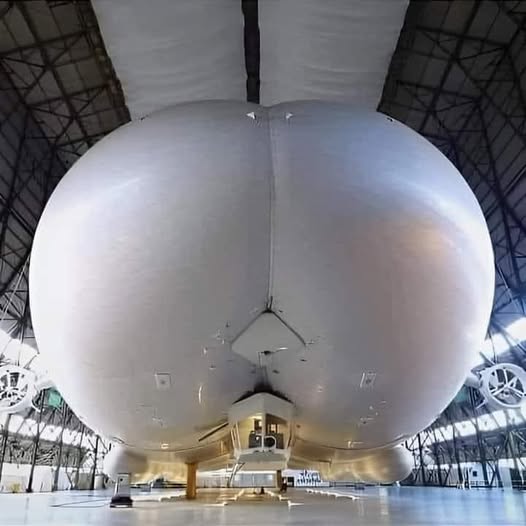The World’s Largest Aircraft: Airlander 10 Prepares to Take Flight

In the world of aviation, innovation continues to break barriers, and the Airlander 10 is a testament to this progress. This colossal, helium-filled hybrid airship, now fully assembled, was recently unveiled in a massive aviation hangar near London. Its unique design and groundbreaking technology promise to redefine modern air travel, combining the principles of traditional airships and fixed-wing aircraft to create an engineering marvel.
What Is the Airlander 10?
The Airlander 10 is the largest aircraft in the world, stretching a remarkable 300 feet (92 meters) in length, surpassing even the largest passenger planes. Its innovative hybrid design allows it to achieve lift through both aerostatic and aerodynamic forces, making it distinct from conventional airships.
Unique Design Features
- Elliptical Hull Shape:
Unlike traditional airships with a circular cross-section, the Airlander 10 boasts an elliptical, contoured, and flattened hull. This intentional design turns the hull into a lifting body, meaning the airship itself contributes to lift generation during forward motion. This feature makes it more efficient and capable of achieving up to 50% of its lift aerodynamically, similar to the wings of an airplane. - Helium Buoyancy:
The aircraft is filled with helium, a non-flammable gas that provides buoyancy and supports between 60% and 80% of the Airlander 10’s weight. Helium not only ensures safety compared to hydrogen but also maintains the airship’s distinctive shape through internal pressure. - Hybrid Propulsion System:
The Airlander 10 is powered by four fuel-efficient, low-emission diesel engines. Two engines are mounted on the rear of the hull, while the other two are on the forward sides. This configuration provides thrust and maneuverability, enabling the airship to hover, land, and take off vertically like a helicopter. - Eco-Friendly Operations:
As a hybrid airship, the Airlander 10 is designed with sustainability in mind. Its lower fuel consumption compared to traditional aircraft reduces its carbon footprint, making it an attractive choice for environmentally conscious industries.
Capabilities and Potential Applications
- Unmatched Payload and Range:
The Airlander 10 can carry payloads of up to 10 tons (22,000 pounds) and travel distances of over 4,000 nautical miles. Its ability to stay airborne for up to five days unmanned or 90 hours with a crew makes it ideal for a range of applications. - Versatile Landing Abilities:
The aircraft requires no dedicated airport or runway for landing. It can take off and land on various surfaces, including water, ice, sand, and even unprepared terrain. This adaptability opens doors for use in remote or disaster-stricken areas where conventional aircraft cannot operate. - Applications Across Industries:
The Airlander 10’s capabilities make it suitable for a wide array of uses:- Cargo Transportation: Its high payload capacity and long range make it ideal for delivering goods to remote areas.
- Tourism and Luxury Travel: Its spacious cabin and panoramic views offer a unique and luxurious travel experience.
- Surveillance and Monitoring: With the ability to stay airborne for extended periods, it can be used for environmental monitoring, border surveillance, and disaster assessment.
- Scientific Research: Its stable platform is perfect for conducting research in hard-to-reach areas, such as polar regions or dense rainforests.
Engineering Marvel: A Lifting Body in Action
The Airlander 10’s hybrid design challenges traditional notions of aircraft engineering. While conventional airships rely entirely on buoyant gas for lift, the Airlander integrates the concept of a lifting body. The flattened hull acts like an airfoil, generating additional lift during forward motion. This innovation allows the aircraft to reduce its reliance on helium, improving performance and stability.
Challenges and the Path Forward
While the Airlander 10 is a remarkable technological feat, it is not without challenges. Manufacturing and operating such a massive aircraft require significant investment. Additionally, its relatively slow speed of around 90 miles per hour (144 km/h) limits its use for time-sensitive operations.
However, the advantages far outweigh the limitations. With growing interest in sustainable and versatile aviation solutions, the Airlander 10 is poised to become a game-changer. Hybrid Air Vehicles (HAV), the company behind its development, envisions a future where these airships revolutionize logistics, transportation, and eco-tourism.
A Glimpse Into the Future
As the Airlander 10 prepares for its first major flight, it symbolizes a step forward in aviation history. This fusion of aerostatic and aerodynamic innovation brings the best of both worlds, offering a more sustainable and adaptable alternative to traditional aircraft.
The unveiling of this behemoth is not just a milestone for HAV but a glimpse into the future of aviation—a future where large, efficient, and eco-friendly airships may once again dominate the skies. The Airlander 10 reminds us that sometimes, looking to the past can inspire the innovations of tomorrow.